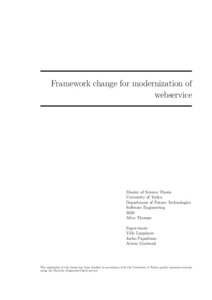Framework change for modernization of webservice
Thomas, Alice (2020-12-03)
Framework change for modernization of webservice
Thomas, Alice
(03.12.2020)
Julkaisu on tekijänoikeussäännösten alainen. Teosta voi lukea ja tulostaa henkilökohtaista käyttöä varten. Käyttö kaupallisiin tarkoituksiin on kielletty.
avoin
Julkaisun pysyvä osoite on:
https://urn.fi/URN:NBN:fi-fe20201217101231
https://urn.fi/URN:NBN:fi-fe20201217101231
Tiivistelmä
Software companies that provide Software as a service, constantly seek to improve their product, by adding features according to the customer's needs. In an attempt to meet all the deadlines set by the customer, an important aspect of software development that gets neglected is code maintenance and code modernization, since this is not something that a customer demands of the software. But from a developer's stand point, a good software is one that is easy to work with and easy to maintain. In the long term ignoring code modernization will produce legacy code. Legacy code need not be code that is old, instead it can be code that is written in an outdated language, or has libraries that are no longer vendor supported. Legacy code then leads to different types of technical debt. This inadvertently affects the customer, because as the technical debt of the codebase increases, new feature development or maintenance will become more expensive and time consuming.
This was the situation in the chosen case study company. This thesis focuses on studying the different types of technical debt and the possible code modernization methods and strategies that could be applied to a legacy system and possibly reduce technical debt and make the code more maintainable and modern. For this thesis, the modernization process selected is the Chicken Little methodology. This technique allows both the legacy system and the target system to run in parallel by using gateways, and this is an important feature for this project. Especially during the client-testing phase or in the first few months after the new system is taken into production, if there are any issues with the system, customers can be directed to the old system without losing business. In each step of this technique minimal functionality is selected, there by reducing the chance of risk.
By following the steps of the chosen methodology to change the framework, the benefits identified were, easier code re-usability and thus code maintainability, reduced lines of code, more unit test cases and many more. Thereafter, concluding the thesis.
This was the situation in the chosen case study company. This thesis focuses on studying the different types of technical debt and the possible code modernization methods and strategies that could be applied to a legacy system and possibly reduce technical debt and make the code more maintainable and modern. For this thesis, the modernization process selected is the Chicken Little methodology. This technique allows both the legacy system and the target system to run in parallel by using gateways, and this is an important feature for this project. Especially during the client-testing phase or in the first few months after the new system is taken into production, if there are any issues with the system, customers can be directed to the old system without losing business. In each step of this technique minimal functionality is selected, there by reducing the chance of risk.
By following the steps of the chosen methodology to change the framework, the benefits identified were, easier code re-usability and thus code maintainability, reduced lines of code, more unit test cases and many more. Thereafter, concluding the thesis.
